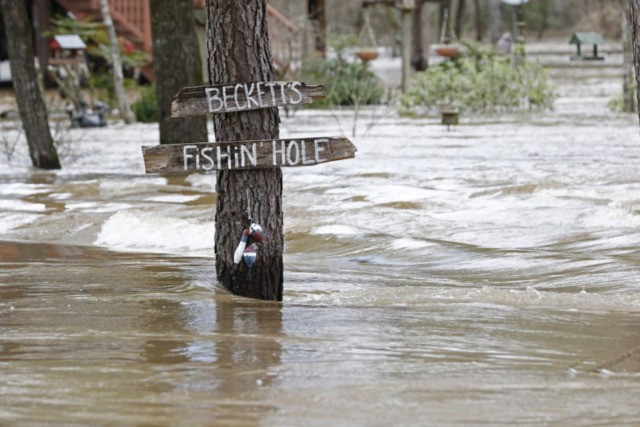JACKSON, Miss. (AP) — The swollen Pearl River appeared to have crested Monday in Mississippi’s capital, but authorities warned the hundreds of evacuees in the Jackson area not to rush back home until they got the all clear, and a forecast of more rain put counties further south at risk of flooding.
No injuries were reported from the major flooding in central Mississippi and southern Tennessee. But as the high water recedes, officials expect to find damaged roads and problems with water and sewage pipes. In Savannah, Tennessee, two houses slid down a muddy bluff into the Tennessee River, although its residents had fled earlier.
“Please do not move back into your neighborhood or into your home until authorities and officials give you the OK to do so,” Mississippi Gov. Tate Reeves said at a news conference.
A near-record rainy winter has forced authorities to release water from swollen reservoirs, potentially worsening the flooding for those living downstream.
“It is a chess match we’re playing with Mother Nature,” said Jim Hopson, spokesman for the Tennessee Valley Authority.
The Pearl River appeared to crest at just under 37 feet (11.3 meters), Reeves said. It is forecast to fall below major flood stage at 36 feet (11 meters) around midnight Tuesday, although more problems could arise if rains in the next few days are heavier than forecast.
“We as a state are not in the clear yet,” Reeves said.
The Pearl’s highest recorded crest was 43.2 feet on April 17, 1979. The second-highest level occurred May 5, 1983, when the river rose to 39.58 feet.
Reeves thanked residents for heeding evacuation orders. Only 16 search-and-rescue missions were needed, he said, even though as many as 1,000 homes were flooded.
One of those homes belongs to Chris Sharp, who had enough time to find an 18-wheeler, load it with his possessions and drive away Friday from the house his parents bought in the 1970s. The house was inundated in those previous two flood years.
On Monday, he tried to go back with a boat, but a police officer turned him away.
“All you can do is just sit back and watch,” Sharp said by phone from his brother’s nearby house.
He expects several inches of water in his home, and this flood finally has Sharp considering whether his family should move. The home isn’t covered by flood insurance because he said the cost has grown too expensive in recent years.
“I’ve been through it before, so I kind of knew what to do,” Sharp said, giving a resigned laugh. “But there’s a bunch of people who didn’t do anything.”
Elsewhere in Jackson, residents paddled canoes, kayaks and small fishing boats to check on their houses, giving lifts to other neighbors. Some were able to enter their homes, while others peeked into the windows to check on damage inside. Floodwaters lapped at mailboxes, street signs and cars that had been left in driveways.
The momentary break in the rain enabled water levels at the Barnett Reservoir upriver of the capital to stabilize, but officials repeated their warnings to pay attention to evacuation orders, check on road closures before traveling and stay off any flooded roads.
Mississippi emergency management officials said Sunday that they had received preliminary damage reports from 11 counties connected with the severe weather that began on Feb. 10.
River gauges in four states from South Carolina west to Mississippi are reporting moderate flooding, according to the U.S. Geological Survey.
Forecasters predict more rain across the Southeast this week. It shouldn’t be as heavy as previous weeks, but with lakes and reservoirs nearing capacity, it won’t take a deluge to require authorities to release more water.
Dramatic video posted by a Tennessee fire department showed the impact near Savannah: Two houses tumbled down a bluff over the Tennessee River, while many others have been swamped to their rooftops, as entire neighborhoods disappear in muddy water below the Tennessee Valley Authority’s Pickwick Reservoir.
Dozens of other homes in more low-lying areas were swamped, the department’s drone video showed.
“It absolutely kills you, knowing that” houses are getting destroyed downstream from the dam, the TVA’s Hopson told The Associated Press on Monday. “We have engineers on duty 24-7 trying to figure out what’s the most effective way to move this water downstream with the least impact. They feel it. I feel it.”
February’s rains have been “400 percent of normal, and we have more coming in this week. It’s kind of a never-ending battle,” Hopson added.
The Pickwick is the next-to-last dam in the TVA’s system, and all the water from a river basin stretching into Virginia and Georgia has to flow through it before reaching the Ohio River and then the Mississippi. Water levels behind upstream tributary dams used to contain the flooding have risen as much as 40 feet this month, but even then, the Pickwick was releasing 2.36 million gallons per second Monday, down only slightly from 2.5 million gallons per second Sunday night, Hopson said.
“Mother Nature is really the one in charge — we simply try to manage what Mother Nature gives us, to minimize the impacts along the 652-mile Tennessee River and its thousands of miles of tributaries and streams,” Hopson said.
___
Deslatte reported from Baton Rouge, Louisiana. Jeffrey Collins in Columbia, South Carolina, and Michael Warren in Atlanta contributed.

COMMENTS
Please let us know if you're having issues with commenting.